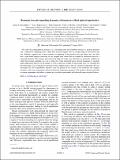Resonant two-site tunnelling dynamics of bosons in a tilted optical superlattice
Abstract
We study the nonequilibrium dynamics of a one-dimensional Bose-Hubbard model in a gradient potential and a superlattice, beginning from a deep Mott insulator regime with an average filling of one particle per site. Studying a quench that is near resonance to tunneling of the particles over two lattice sites, we show how a spin model emerges consisting of two coupled Ising chains that are coupled by interaction terms in a staggered geometry. We compare and contrast the behavior in this case with that in a previously studied case where the resonant tunneling was over a single site. Using optimized tensor network techniques to calculate finite-temperature behavior of the model, as well as finite-size scaling for the ground state, we conclude that the universality class of the phase transition for the coupled chains is that of a tricritical Ising point. We also investigate the out-of-equilibrium dynamics after the quench in the vicinity of the resonance and compare dynamics with recent experiments realized without the superlattice geometry. This model is directly realizable in current experiments and reflects a general way to realize spin models with ultracold atoms in optical lattices.
Citation
Buyskikh , A S , Tagliacozzo , L , Schuricht , D , Hooley , C A , Pekker , D & Daley , A J 2019 , ' Resonant two-site tunnelling dynamics of bosons in a tilted optical superlattice ' , Physical Review. A, Atomic, molecular, and optical physics , vol. 100 , no. 2 , 023627 , pp. 1-12 . https://doi.org/10.1103/PhysRevA.100.023627
Publication
Physical Review. A, Atomic, molecular, and optical physics
Status
Peer reviewed
ISSN
1050-2947Type
Journal article
Description
Funding: Strathclyde: UK EPSRC Program Grant DesOEQ (No.EP/P009565/1), the European Union Horizon 2020 collaborative project Quantum Probes for Complex Systems (Grant Agreement No. 641277), and by the EOARD via AFOSR Grant No. FA9550-18-1-0064.Collections
Items in the St Andrews Research Repository are protected by copyright, with all rights reserved, unless otherwise indicated.

